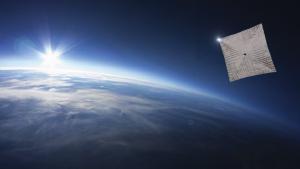Blog
To Sail the Cosmic Sea
20 February 2020
 Josh Spradling / The Planetary Society
Josh Spradling / The Planetary SocietyIt has long been a dream of humanity to travel among the stars. Perhaps someday, if we survive as a species, we can explore the galaxy on great starships. It’s a big dream, and it would be a tremendous engineering feat.
One of the greatest challenges is how we could even reach other stars. Our solar system is vast, but it is dwarfed by stellar distance. Even light takes years to reach the nearest stars. For humans to make such a journey in a reasonable timeframe, our starships will need to travel at relativistic speeds. But this would take far more energy than we currently produce.
While engineers have envisioned powerful rockets to reach relativistic speeds, they have also looked at alternatives such as solar sails to harness the momentum of light, or ways to capture the stream of charged particles that stream through interstellar space. After all, there are powerful natural energy sources in the universe. Why not harness them?
Recently a team looked at these ideas and explored one step further.1 If humans someday use natural powerhouses to travel the stars, wouldn’t other advanced civilizations? If they did, could we see evidence of advanced aliens sailing between the stars?
Their paper looks at two technologies: light sails, which use light to push a starship into space, and electric sails, which use an electric field to deflect charged particles in space to accelerate the starship. They found that with light sails, the maximum speed of a starship depends upon the luminosity of the light source. By harnessing the light of a star, a light sail ship could only reach a small fraction of light speed. However, harnessing the light of microquasars or supernovae could accelerate a ship up to a few percent of the speed of light. An electric sail could achieve similar speeds from a star but performs better with powerful sources. By harnessing a microquasar, for example, an electric sail could achieve more than 10% of light speed.
Even at these speeds, a starship would take decades or centuries to reach another star. But forward-thinking species, it could be worth doing. If aliens are using such technology, how might we detect them? The team notes that one way would be to focus on powerful astrophysical sources such as microquasars. If aliens are reflecting light with a solar sail, or deflecting streams of ionized gas with an electric sail, there could be signatures in the light spectra hinting at an artificial source. But the team also notes that the best way to see these starships would be to look for radio signals.
Finding evidence of aliens in this way is a long shot. Even a galactic fleet would be very difficult to detect. But it is interesting to speculate about what we might find. And someday we might be pleasantly surprised.
Lingam, Manasvi, and Abraham Loeb. “Propulsion of Spacecrafts to Relativistic Speeds Using Natural Astrophysical Sources.” arXiv preprint arXiv:2002.03247 (2020). ↩︎